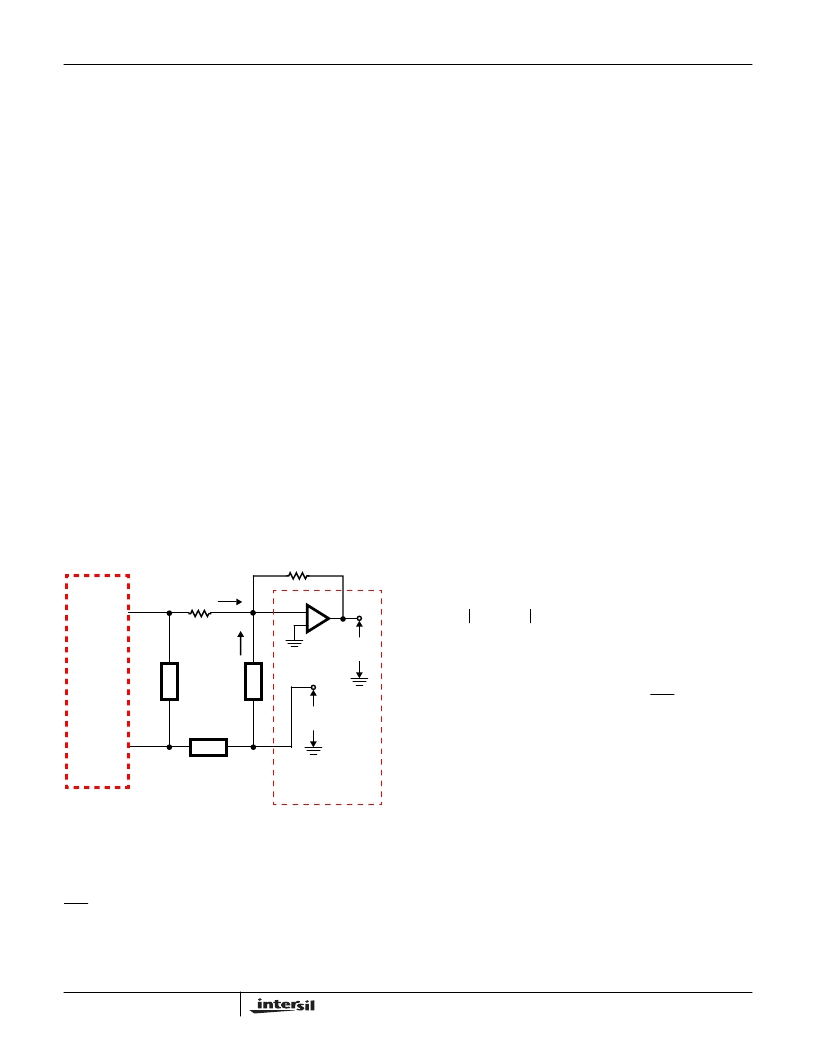- 您現(xiàn)在的位置:買賣IC網(wǎng) > PDF目錄371775 > HC5513 (Intersil Corporation) Bipolar Transistor; Package/Case:TO-220; Current Rating:7A; Voltage Rating:80V RoHS Compliant: Yes PDF資料下載
參數(shù)資料
| 型號: | HC5513 |
| 廠商: | Intersil Corporation |
| 英文描述: | Bipolar Transistor; Package/Case:TO-220; Current Rating:7A; Voltage Rating:80V RoHS Compliant: Yes |
| 中文描述: | TR909金剛石/解陣用戶接口低功耗待機 |
| 文件頁數(shù): | 11/18頁 |
| 文件大小: | 175K |
| 代理商: | HC5513 |

64
Transhybrid Circuit
The purpose of the transhybrid circuit is to remove the
receive signal (V
RX
) from the transmit signal (V
TX
), thereby
preventing an echo on the transmit side. This is
accomplished by using an external op amp (usually part of
the CODEC) and by the inversion of the signal from the
4-wire receive port (RSN) to the 4-wire transmit port (V
TX
).
Figure 17 shows the transhybrid circuit. The input signal will
be subtracted from the output signal if I
1
equals I
2
. Node
analysis yields the following equation:
The value of Z
B
is then:
Where V
RX
/V
TX
equals 1/ A
4-4
.
Therefore:
Example:
Given: R
TX
= 20k
, Z
RX
= 280k
, Z
T
= 562k
(standard
value), R
F
= 20
and Z
L
= 600
,
The value of Z
B
= 18.7k
.
Supervisory Functions
The loop current, ground key and the ring trip detector
outputs are multiplexed to a single logic output pin called
DET. See Table 1 to determine the active detector for a given
logic input. For further discussion of the logic circuitry see
section titled “Digital Logic Inputs”.
Before proceeding with an explanation of the loop current
detector, ground key detector and later the longitudinal
impedance, it is important to understand the difference
between a “metallic” and “l(fā)ongitudinal” loop currents. Figure
18 illustrates 3 different types of loop current encountered.
Case 1 illustrates the metallic loop current. The definition of
a metallic loop current is when
equal
currents flow out of tip
and into ring. Loop current is a metallic current.
Cases 2 and 3 illustrate the longitudinal loop current. The
definition of a longitudinal loop current is a common mode
current, that flows either out of or into tip and ring
simultaneously. Longitudinal currents in the on-hook state
result in
equal
currents flowing through the sense resistors
R
1
and R
2
(Figure 18). And longitudinal currents in the off-
hook state result in
unequal
currents flowing through the
sense resistors R
1
and R
2
. Notice that for case 2,
longitudinal currents flowing away from the SLIC, the current
through R
1
is the metallic loop current plus the longitudinal
current; whereas the current through R
2
is the metallic loop
current minus the longitudinal current. Longitudinal currents
are generated when the phone line is influenced by
magnetic fields (e.g., power lines).
Loop Current Detector
Figure 18 shows a simplified schematic of the loop current
and ground key detectors. The loop current detector works
by sensing the metallic current flowing through resistors R
1
and R
2
. This results in a current (I
RD
) out of the
transconductance amplifier (gm
1
) that is equal to the product
of gm
1
and the metallic loop current. I
RD
then flows out the
R
D
pin and through resistor R
D
to V
EE
. The value of I
RD
is
equal to:
The I
RD
current results in a voltage drop across R
D
that is
compared to an internal 1.25V reference voltage. When the
voltage drop across R
D
exceeds 1.25V, and the logic is
configured for loop current detection, the DET pin goes low.
The hysteresis resistor R
H
adds an additional voltage
effectively across R
D
, causing the on-hook to off-hook
threshold to be slightly higher than the off-hook to on-hook
threshold.
Taking into account the hysteresis voltage, the typical value
of R
D
for the on-hook to off-hook condition is:
Taking into account the hysteresis voltage, the typical value
of R
D
for the off-hook to on-hook condition is:
V
TX
-----------
V
B
-----------
+
0
=
(EQ. 21)
Z
B
R
–
TX
V
TX
-----------
=
(EQ. 22)
Z
B
R
TX
Z
T
-----------
Z
------------------+
------------
2R
F
F
Z
L
+
+
L
=
(EQ. 23)
HC5513
V
TX
RSN
R
TX
R
FB
CODEC/
FILTER
I
1
I
2
V
TX
Z
RX
Z
T
+
-
Z
B
V
RX
+
-
+
-
FIGURE 17. TRANSHYBRID CIRCUIT
I
RD
I
-----------------------------------
I
–
I
---------
=
=
(EQ. 24)
R
D
ON
HOOK to OFF
–
HOOK
–
--------------------------------------------------------------------------
=
(EQ. 25)
R
D
OFF
HOOK to ON
–
HOOK
–
--------------------------------------------------------------------------
=
(EQ. 26)
HC5513
相關PDF資料 |
PDF描述 |
|---|---|
| HC5513BIM | TVS UNI-DIR 40V 1500W SMC |
| HC55171BIB | Low Cost 5 REN Ringing SLIC for ISDN Modem/TA and WL |
| HC55171B | Low Cost 5 REN Ringing SLIC for ISDN Modem/TA and WL |
| HC55171BIM | Low Cost 5 REN Ringing SLIC for ISDN Modem/TA and WL |
| HC55171IB | 5 REN Ringing SLIC for ISDN Modem/TA and WLL |
相關代理商/技術參數(shù) |
參數(shù)描述 |
|---|---|
| HC5513_03 | 制造商:INTERSIL 制造商全稱:Intersil Corporation 功能描述:TR909 DLC/FLC SLIC with Low Power Standby |
| HC55130 | 制造商:INTERSIL 制造商全稱:Intersil Corporation 功能描述:Low Power Universal SLIC Family |
| HC55130IB | 制造商:Rochester Electronics LLC 功能描述:LOW PWR SLIC,63DB BALANCE - Bulk |
| HC55130IB96 | 制造商:INTERSIL 制造商全稱:Intersil Corporation 功能描述:Low Power Universal SLIC Family |
| HC55130IBZ | 功能描述:電信線路管理 IC LW PWR SLIC 63DB BALANCE RoHS:否 制造商:STMicroelectronics 產(chǎn)品:PHY 接口類型:UART 電源電壓-最大:18 V 電源電壓-最小:8 V 電源電流:30 mA 最大工作溫度:+ 85 C 最小工作溫度:- 40 C 安裝風格:SMD/SMT 封裝 / 箱體:VFQFPN-48 封裝:Tray |
發(fā)布緊急采購,3分鐘左右您將得到回復。